|
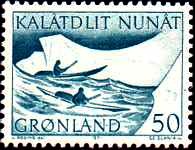
|
Maritime Topics On Stamps:
Kayak and Umiak of the Eskimos!
|
|
The Eskimos, who call themselves Inuits, have been living for thousands of years
in North America, Greenland and Siberia. They are a mongoloid ethnic group numbering
roundabout 135,000 and speak one common language.
Over the years the Eskimos have developed two special boat types for hunting and
transportation - the kayak and the umiak.
Inuit (singular Inuk) translates to 'superior' or simply 'people'. The term Eskimo
derived from an Indian language and means 'raw meat eater'.
|
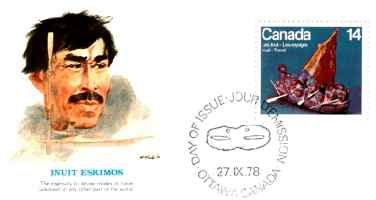
|
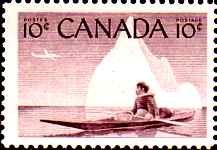
|
An Eskimo kayak is an enclosed one-man boat made of tendon-strapped wood and/or bones
covered with seal or walrus skins. Its flexible skeleton is secured by leather straps.
The boat has a seat hole and is propelled by using a double paddle.
The Eskimo hunter, sitting in the kayak, wore an anorak manufactured of hides and furs.
The anorak tightly fit the wrists and face so that no water could penetrate.
By closing the boat opening with the anorak the boat was fully enclosed and watertight.
Man and boat became one unit.
|
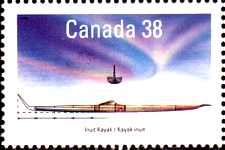
|
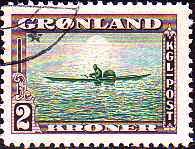
| |
Over the centuries several different kayak types were developed depending on region
and purpose. The shortest and most akward one was called koryak. It had a length of
only 10 feet and was used for hunting in Kamchatka. On Greenland the length of a
kayaks reached up to 20 feet, the width up to 1.5 feet. In some areas of the Aleutian
Islands and Alaska there were also kayaks for two to three persons, which were
suitably longer. The tanning of the hides and the sewing of the outer hull were
almost exclusively done by the eskimo women. Leathers and seams were greased with
seal fat and fish oil. The outer skin had to be renewed at least every two years.
If a kayak was used on a daily basis this time span narrowed to a year.
|
|
The typical equipment of a kayak consisted of a double paddle, a harpoon, a throwing
spear and a swimming skin. The weapons were tied to the boat with leather belts. The
swimming skin was fastened behind the back of the hunter (as depicted on the Greenland
stamp above). On the stamp to the right you can see a kayak glove with two thumbs.
If one thumb became wet from paddling, the glove could be turned around. So the wet
thumb could dry and the hunter could use the spare for operating the weapons.
|
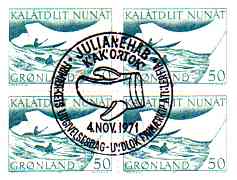
|

|
In rough seas an Eskimo hunter was always in danger of capsizing. The Eskimos
developed a special manoeuvre called 'the Eskimo roll', which enabled them to
raise a capsized boat with a single skillful paddle stroke. They knew
approximately 25 different variations of the roll. In some situations an Eskimo
intentionally did the roll, e.g. if a dangerously high wave headed for the kayak.
If he could capsize in the right moment he was able to intercept the force of the
wave with the keel of the kayak.
|
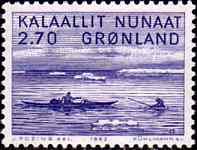
|

| |
The kayaks were primarily used for seal (sea-dogs and walruses), bird and
reindeer hunting (caribous). The hunter used an additional spear, a harpoon, which
was tied to a swimming skin. The skin prevented the seal from diving away. It also
acted as a marker of the current location of the prey. The hunt for walruses was
the most dangerous. These animals can reach a length of up to 15 feet, weighing
nearly a ton and sporting two 2 feet long teeth. A hit walruses often tries to
attack the boat and is easily capable of destroying them. In Northern Greenland
Eskimos used open kayaks so they could leave the boat as fast as possible. Several
boats teamed up, when a walrus hunt was due. On the stamp to the left you can see
a seal hit by a spear, to the right a caribou hunt.
|
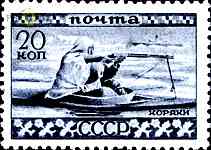
|

| |
Today the rifle replaced the javelin. During the course of the Danish
colonization of Greenland the kayak was also used for postal services e.g.
transporting mail to remote locations. Kayaks were always sent in pairs for
safety reasons. The letters were stowed away in waterproof bags behind
the paddle man, like the swimming skins of the hunters. This is depicted in the
first stamp on top of this side.
|

|

| |
The umiak is an open boat used for whale-catching and transportation (also
called 'women boat' by the Eskimos). It consists of a wooden framework covered
with sea-dog skins. Frames and keel are tied with tendons and leather strips.
Nails were not used because they can rust and cause the skins to rot. The upper
ends of the frames were tied to circulating woods, which also held the thwarts
(seats) in place. On the boat bottom timbers were placed crosswise. The average
length of an umiak reached 22 to 33 feet, width about 5 feet. Sometimes the
umiaks had also a small mast on the bow with a square sail made from reindeer
skins (see the stamp above). The umiaks are called women boats, because it was
an indignity for a man to touch a paddle in an umiak. The man sits aft and
steers, the women are rowing. The boats could carry 10 to 12 persons, while
being ashore it could be carried by six persons.
|
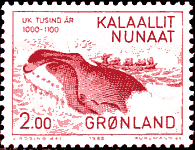
|
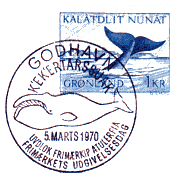
| |
The umiak was used for transportation, when whole families changed their
dwelling place and big loads had to be moved. It served for seal and especially
whale hunting. Whale hunting is an ancient tradition. In the legends of the
Eskimos exists a friendly community between humans and whales. Since a whale
can feed a whole settlement for months, the whale symbolizes the unity of
mankind and nature. The spirit of a slain whale returns to the water and
is reborn! The whalers carried waterproof so-called 'jumping furs'. They
could be inflated and protected the hunter against the cold water for a
while. The whaler jumped onto the back of the already harpooned animal and
kept stabbing until the whale died. On the Aleutian Island the harpoon
tips were poisoned with alconite. It was sufficient to cause a minor wound
onto the whale. It died and was driven to the coast by wind and current.
|
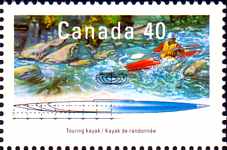
|
Today there are about 100 different types of kayaks. One can divide these
types into touring kayaks, sea kayaks and fast water kayaks. More uncommon
are the folding boats and inflatable tube kayaks.
|
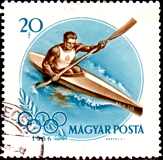
|
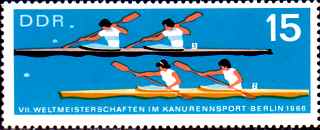
| |
All of today's kayak types are manufactured as one or two-seaters. Racing sport also
has the four seater. The boats are made either of plastics such as glass fibers,
carbon, kevlar etc. (plastic boats), or of polyethylene (so-called thermoplastic boats).
|
|